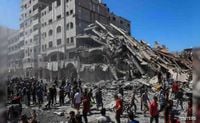On October 3 and 4, 2025, a significant—though complex—development unfolded in the ongoing Gaza conflict, as Hamas announced its conditional agreement to release all Israeli hostages, both living and dead. The move came in response to a high-profile, US-brokered 20-point peace plan introduced by President Donald Trump, which aims to bring an end to nearly two years of devastating warfare in the region. While the announcement has sparked hope among families of hostages and drawn cautious optimism from international leaders, deep divisions remain over the plan’s most contentious provisions, leaving the prospect of lasting peace hanging in the balance.
The Trump administration’s peace proposal, delivered to Hamas via Qatari and Egyptian mediators, calls for an immediate ceasefire, the simultaneous release of all 48 remaining hostages (including the remains of those killed), a phased Israeli withdrawal from Gaza, the entry of humanitarian aid, and the creation of a new civilian Palestinian governing authority. The framework also demands the disarmament of Hamas and the transfer of Gaza’s administrative control to an independent Palestinian body, with oversight from an international "Board of Peace" chaired by Trump himself. Regional actors such as Qatar, Turkey, Saudi Arabia, Egypt, and Jordan have all played roles in facilitating the talks.
According to The New York Post, President Trump described October 3 as a “very special, maybe unprecedented” day and thanked the countries involved for their diplomatic efforts. He expressed hope that “we’re very close to achieving” peace and added, “Very importantly, I look forward to having the hostages come home to their parents.” Trump also issued a stern warning, giving Hamas until 6 p.m. ET on October 5 to accept the plan, promising that failure would bring “all hell” down on the group.
Hamas’s response, delivered in a carefully worded statement and posted by Trump on his Truth Social platform, signaled acceptance of the hostage release—albeit with conditions. The group stated it was ready to “immediately begin negotiations through mediators to finalize details of the arrangement,” but insisted that the release would only take place once “field conditions are met”—meaning, in practice, that Israel must pull back its forces to the lines specified in the peace plan. As BBC reported, Hamas media adviser Tahir al-Nounou called Trump’s statements “encouraging” and said the movement was “ready to begin negotiations immediately to achieve a prisoner exchange, end the war, and secure the withdrawal of the occupation.”
Yet, while Hamas’s willingness to discuss the plan marks a significant step, the group made it clear that several provisions remain highly contentious. Most notably, Hamas rejected outright the demand for its disarmament and objected to the proposed international "Board of Peace" as an unacceptable form of external control. Instead, Hamas has proposed handing over Gaza’s administration to a Palestinian body of independents—technocrats—formed by national consensus and supported by Arab and Islamic states, rather than following the US blueprint directly. The group also insists on a full and complete Israeli withdrawal from Gaza, as opposed to the staged pullback outlined in Trump’s plan.
“All details related to the peacekeeping force need understandings and clarification,” stated Mousa Abu Marzouk, Hamas’s foreign-relations head in Qatar, in an interview with Al Jazeera. He added that while Hamas agreed in principle to hand Gaza’s administration to independents backed by Palestinian consensus, “the priority is to stop the war and massacres,” and warned the group “would not accept threats or dictates.” Abu Marzouk also dismissed Trump’s 72-hour timeline for the release of hostages as “theoretical and unrealistic under current circumstances.”
As for the hostages themselves, the situation remains urgent and deeply personal for many families. As of early October 2025, 48 hostages are believed to be held by Hamas, with 20 presumed alive—among them, the names Avinatan Or, Matan Zanguaker, Alon Ohel, Yosef-Chaim Ohana, and others. Two Americans, Itay Chen (19) and Omer Neutra (21), are among the dead. Ruby Chen, father of Itay Chen, wrote on X (formerly Twitter), “Agree with @POTUS that Israel should stop bombing Gaza to create the infrastructure to release the hostages safely.”
The Israeli government has responded with a mix of guarded optimism and skepticism. Prime Minister Benjamin Netanyahu has backed the proposal in principle but warned that Israel would “finish the job” if Hamas rejects or fails to honor the deal. Netanyahu also reiterated his opposition to the plan’s provision for a Palestinian state, telling reporters, “It’s not written in the agreement. We said we would strongly oppose a Palestinian state.” Some Israeli officials, such as Scott Feltman of the One Defense Fund, have expressed doubts about Hamas’s intentions, emphasizing that “they want to maintain weapons, and that’s just not going to happen.”
In the United States, reactions have reflected the polarized landscape of American politics. Senator Lindsey Graham called Hamas’s response “predictable” and “a classic ‘Yes, but’,” criticizing the group’s refusal to disarm or relinquish control. House Representative Dan Goldman, on the other hand, said, “I am relieved that both Israel’s government and Hamas’s leadership have finally agreed that this war must come to an end, with the hostages released, military operations stopped, and humanitarian aid to Palestinian civilians surged.” Representative Marjorie Taylor Greene echoed the need for peace, writing, “The war must end. Too many people have been killed and injured, and peace is badly needed.”
White House Press Secretary Karoline Leavitt underscored the gravity of the moment, stating that the repercussions of rejecting the plan would be “very grave” for Hamas. “Hamas has an opportunity to accept this plan and move forward in a peaceful and prosperous manner in the region. If they don’t, the consequences, unfortunately, are going to be very tragic,” she said.
Meanwhile, the toll of the conflict continues to mount. Since the Hamas-led attack on October 7, 2023—which killed approximately 1,200 Israelis and resulted in the taking of 251 hostages—more than 66,000 people have reportedly been killed in Gaza, according to the Hamas-run health ministry. Israeli forces remain engaged in heavy operations around Gaza City, with Defense Minister Yoav Gallant stating they are “tightening the siege.” International humanitarian organizations, such as UNICEF, have condemned the ongoing violence, with spokesperson James Elder describing the so-called safe zones in Gaza as “farcical.”
Despite the many hurdles that remain, some observers see the current negotiations as the most promising opportunity for peace in years. The Palestinian Authority has called Trump’s efforts “sincere and determined,” and leaders from Europe and the Middle East have expressed cautious support. The coming days will be decisive, as all parties weigh the risks and rewards of a deal that could finally bring a measure of relief to a region battered by war and loss.
For now, hope and uncertainty coexist. The world watches as negotiators try to bridge the gaps—and as families on both sides wait, with bated breath, for news that could change everything.


